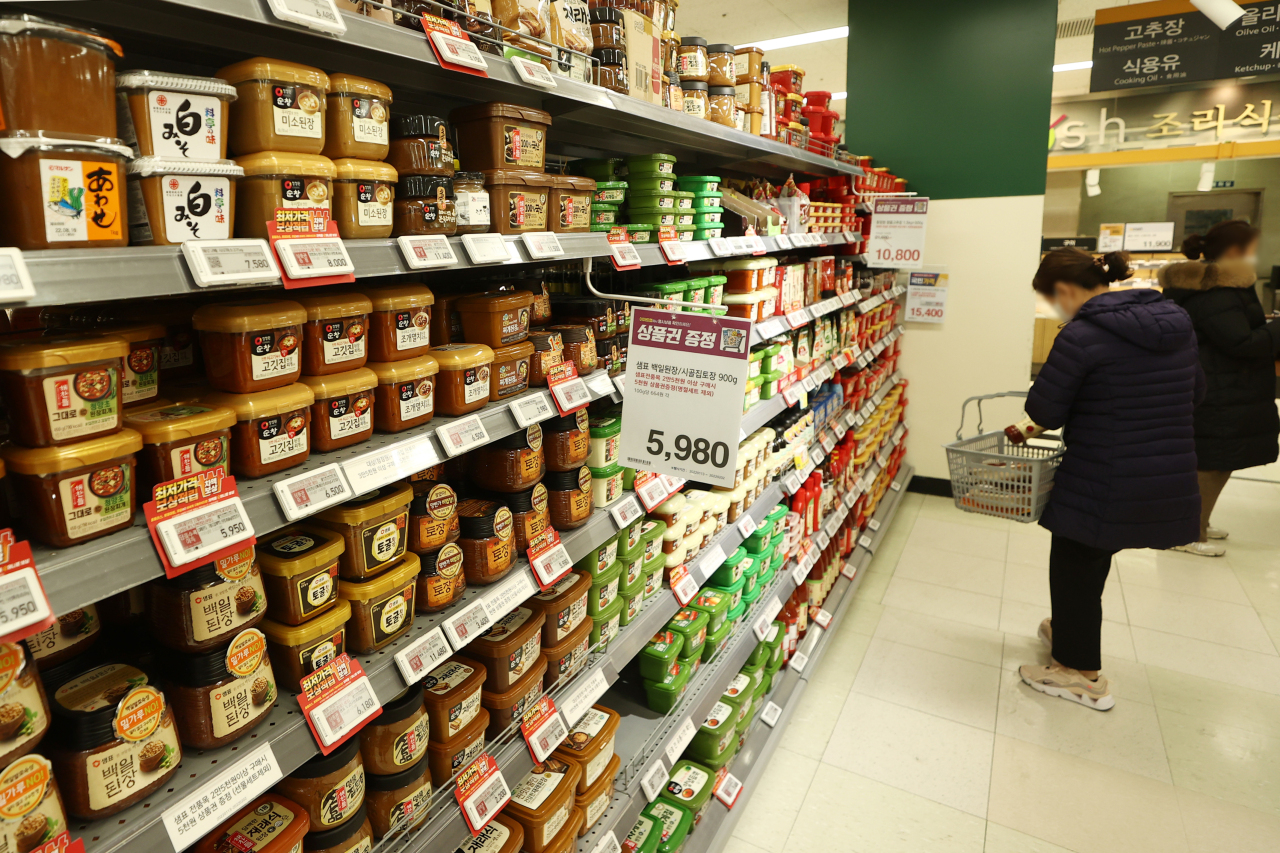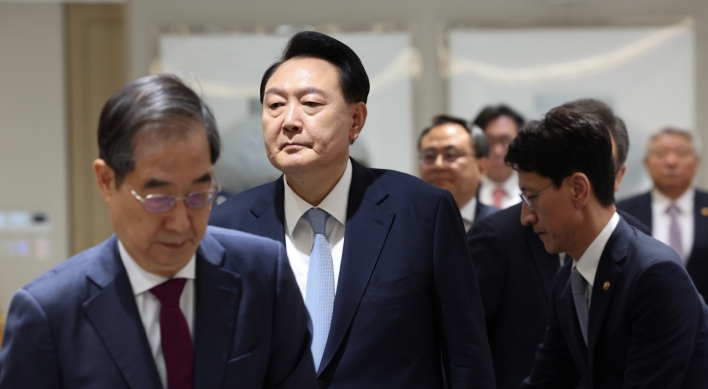Prices growth in groceries, car fuel hits 10-year high
By Kim Yon-sePublished : Jan. 24, 2022 - 16:23

SEJONG -- Consumer prices of groceries and transportation in Korea climbed fastest in a decade in 2021, which have posed aggravated burden on households amid the pandemic, state data showed Monday.
These two items were found to have led the instability in overall consumer prices last year, despite the Bank of Korea’s interest rate hikes twice in August and November.
According to Statistics Korea, consumer prices of groceries rose 5.9 percent in 2021, compared to the previous year -- 6.2 percent for food and 1.8 percent for beverages. This marked the highest growth in 10 years since 2011.
A 11.4 percent surge was seen in prices of milk, cheese and eggs, 10.7 percent in fruit, 8.4 percent in meat, 7.2 percent in edible oil and fats, 6.3 percent in bread and cereals and 4.2 percent in vegetables and seaweed.
The growth in prices of groceries stayed at 2.3 percent in 2016, 3.4 percent in 2017, 2.8 percent in 2018 and zero percent in 2019. It rebounded to 4.4 percent in 2020, and further shot up to 5.9 percent in 2021.
Transportation prices climbed 6.3 percent on-year, which is comprised of fuel for automobiles and fares for buses, trains and flights, with the figure also recording the highest in a decade. Of these, in particular, fuel for automobiles posted a noteworthy growth of 11.1 percent.
This was attributed to a spike in international crude prices, which fanned the surge of 14.8 percent in gasoline prices in the local market, 16.4 percent in diesel prices and 18 percent in liquefied petroleum gas prices.
“As groceries and fuel for cars are classified as daily necessities, it is estimated that a large portion of households suffered heavy cost burden from the prices growth,” a Seoul-based researcher said.
Statistics Korea data also showed that prices of food service at restaurants recorded a 2.8 percent growth, though the growth in lodging service stayed at 0.5 percent.
In contrast, relatively low prices growth was reported in education service at 0.9 percent, clothes and shoes at 0.6 percent, entertainment and culture at 0.4 percent and alcoholic drinks at 0.4 percent.
Social distancing from COVID-19 is estimate to have caused people’s less spending on the items above as they reduced going out and leisure activities.
Though the government has carried out a variety of actions to curb consumer prices, there are few predictions that the growth will stop in the near future.
Researchers say that both recovery in domestic demand and external factors -- such as logistics problem for global supply and surge in energy prices – are still fanning inflation.
A report from the BOK forecasted that a longer-than-expected glitch in global supply will have further effect on the local market, which will build inflationary pressure in wider segments.
Some market observers cast worries over the supplementary budget worth 14 trillion won ($11.7 billion), which will be proposed to the National Assembly this week, in terms of negatively affecting households’ cost burden.
Deputy Prime Minister and Finance Minister Hong Nam-ki predicted that the negative impact would be limited as long as the volume of the extra budget -- to be fostered for microbusiness owners -- is not expanded.
Some ruling party lawmakers are calling for the Finance Ministry to increase the scale from 14 trillion won to 35 trillion won worth.
By Kim Yon-se (kys@heraldcorp.com)
These two items were found to have led the instability in overall consumer prices last year, despite the Bank of Korea’s interest rate hikes twice in August and November.
According to Statistics Korea, consumer prices of groceries rose 5.9 percent in 2021, compared to the previous year -- 6.2 percent for food and 1.8 percent for beverages. This marked the highest growth in 10 years since 2011.
A 11.4 percent surge was seen in prices of milk, cheese and eggs, 10.7 percent in fruit, 8.4 percent in meat, 7.2 percent in edible oil and fats, 6.3 percent in bread and cereals and 4.2 percent in vegetables and seaweed.
The growth in prices of groceries stayed at 2.3 percent in 2016, 3.4 percent in 2017, 2.8 percent in 2018 and zero percent in 2019. It rebounded to 4.4 percent in 2020, and further shot up to 5.9 percent in 2021.
Transportation prices climbed 6.3 percent on-year, which is comprised of fuel for automobiles and fares for buses, trains and flights, with the figure also recording the highest in a decade. Of these, in particular, fuel for automobiles posted a noteworthy growth of 11.1 percent.
This was attributed to a spike in international crude prices, which fanned the surge of 14.8 percent in gasoline prices in the local market, 16.4 percent in diesel prices and 18 percent in liquefied petroleum gas prices.
“As groceries and fuel for cars are classified as daily necessities, it is estimated that a large portion of households suffered heavy cost burden from the prices growth,” a Seoul-based researcher said.
Statistics Korea data also showed that prices of food service at restaurants recorded a 2.8 percent growth, though the growth in lodging service stayed at 0.5 percent.
In contrast, relatively low prices growth was reported in education service at 0.9 percent, clothes and shoes at 0.6 percent, entertainment and culture at 0.4 percent and alcoholic drinks at 0.4 percent.
Social distancing from COVID-19 is estimate to have caused people’s less spending on the items above as they reduced going out and leisure activities.
Though the government has carried out a variety of actions to curb consumer prices, there are few predictions that the growth will stop in the near future.
Researchers say that both recovery in domestic demand and external factors -- such as logistics problem for global supply and surge in energy prices – are still fanning inflation.
A report from the BOK forecasted that a longer-than-expected glitch in global supply will have further effect on the local market, which will build inflationary pressure in wider segments.
Some market observers cast worries over the supplementary budget worth 14 trillion won ($11.7 billion), which will be proposed to the National Assembly this week, in terms of negatively affecting households’ cost burden.
Deputy Prime Minister and Finance Minister Hong Nam-ki predicted that the negative impact would be limited as long as the volume of the extra budget -- to be fostered for microbusiness owners -- is not expanded.
Some ruling party lawmakers are calling for the Finance Ministry to increase the scale from 14 trillion won to 35 trillion won worth.
By Kim Yon-se (kys@heraldcorp.com)









![[KH Explains] How should Korea adjust its trade defenses against Chinese EVs?](http://res.heraldm.com/phpwas/restmb_idxmake.php?idx=644&simg=/content/image/2024/04/15/20240415050562_0.jpg&u=20240415144419)








